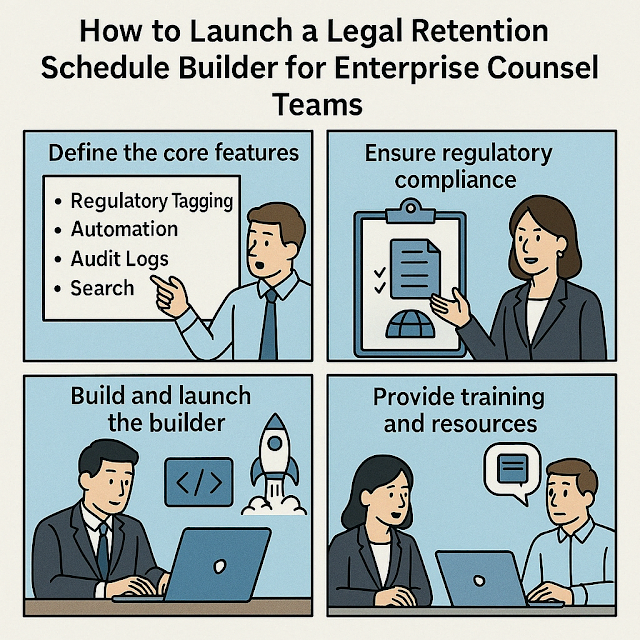How to Launch a Legal Retention Schedule Builder for Enterprise Counsel Teams
In today’s compliance-driven legal landscape, enterprise counsel teams face growing pressure to manage legal records systematically and defensibly.
A Legal Retention Schedule Builder can be a game-changing tool—helping teams automate policy enforcement, align with global regulations, and reduce litigation risks.
Let’s break down how to launch one effectively.
📌 Table of Contents
- Why Legal Retention Schedules Matter
- Core Features to Include
- Meeting Regulatory Requirements
- How to Build and Launch
- Helpful Tools & Resources
Why Legal Retention Schedules Matter
Legal retention schedules are policy frameworks that determine how long a document or piece of data should be kept—and when it should be securely deleted.
Without them, organizations risk non-compliance, data overload, and even regulatory penalties.
For legal departments, especially in highly regulated sectors like healthcare or finance, a formal schedule builder ensures consistency and defensibility.
Core Features to Include in Your Builder
When designing your Legal Retention Schedule Builder, prioritize the following:
Regulatory Tagging: Map documents to laws like GDPR, HIPAA, CCPA, or SOX.
Lifecycle Automation: Enable automatic archival and deletion workflows.
Audit Logs: Track every action taken for audit-readiness.
Searchable Interface: Legal teams should be able to filter by jurisdiction, record type, and more.
Change Control: Build approval-based editing for policy updates.
Meeting Global Regulatory Requirements
Different countries—and even different states—require unique data retention standards.
Ensure your builder supports customizable rules based on region, department, and legal entity.
Use templates for commonly regulated industries to speed up compliance alignment.
How to Build and Launch the Solution
You can launch a custom solution using tools like:
Low-Code Platforms: Use Microsoft Power Apps or OutSystems for faster deployment.
Cloud-Based Architecture: Host the builder on AWS, Azure, or GCP with secure IAM policies.
Legal Taxonomy Models: Structure the builder around classifications used by legal professionals.
Don’t forget change management—offer training for counsel teams and align workflows with existing document management systems like iManage or NetDocuments.
Helpful Tools & Resources
Explore real-world examples, implementation guides, and customizable templates using industry blogs and enterprise-ready platforms.
Here's a hand-picked resource you might find useful:
This site offers insightful posts tailored for legal tech professionals, covering everything from compliance automation to policy lifecycle governance.
🚀 Final Thoughts
Launching a Legal Retention Schedule Builder isn’t just a technology decision—it’s a strategic move for risk mitigation, operational clarity, and regulatory peace of mind.
With the right features, governance alignment, and stakeholder support, your legal team can lead digital transformation with confidence.
Looking for more tech strategies for legal teams? Bookmark our recommended blogs and stay ahead of the compliance curve!
Keywords: Legal Retention, Compliance Automation, Enterprise Legal Tools, Document Governance, Legal Tech






